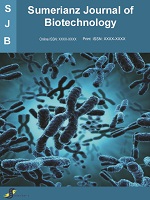Sumerianz Journal of Biotechnology

Online ISSN: 2617-3050
Print ISSN: 2617-3123
Quarterly Published (4 Issues Per Year)
Journal Website: https://www.sumerianz.com/?ic=journal-home&journal=32Archive
Volume 3 Issue 9 (2020)
A Genetic Variability Study of Lipase Producing Gene among Aeromonas Species Isolated From Clinical Isolates by RAPD DNA Markers
Authors : Abdul Ghayum Papulzai ; Nikhiya Manuel John ; V. kurinji ; Sudhakar Malla
Abstract:Lipases are most commonly used enzymes and do have lots of industrial applications. Even though these enzymes are used abundantly, little work was done in isolating the enzyme from microbes. Aeromonas species was the common contaminant of nosocomial infections, which do processes this enzyme. Study of such enzymes and their phylogenetic analysis could reveal loads of information of the organisms applications. We isolated and purified the enzyme from Aeromonas species, from clinical samples. PCR amplification of lipase gene was done to confirm the organism ability to produce lipase. Lipase enzyme was then studied for stability at varying temperatures and pH. The DNA was then used for the RAPD profiling to screen phylogenetic relation. Rhodamine plate assay was used for initial screening of bacteria. Among the 20 isolates screened all of them are lipase positive and only 5 isolates were found to be producing high lipase content. The enzyme was found to be stable at pH 6 and at temperature 27.50C. The phylogenetic analysis revealed that the sequences match to Aeromonas salmonicida, Aeromonas hydrophila, Aeromonas veronii, Aeromonas enteropelogenes and Aeromonas caviae. All the species belong to the same family. This study could pave ways to elucidate and characterize the molecular pathogenesis associated with the lipase gene whch eventually could lead to screening antibacterial targets and novel drugs against many antibiotic resistant nosocomial infections.
Nutritional Bioactive Compounds and Health Benefits of Fresh and Processed Cucumber (Cucumis Sativus L.)
Authors : T. G. G. Uthpala ; R. A. U. J. Marapana ; K. P. C. Lakmini ; D. C. Wettimuny
Abstract:Gherkin (Cucumis sativus L.) generally known as commercial cucumber, is native to the region of Asia, and is now widely cultivated in many other parts of the world to be sold fresh and for pickle production. Cucumber is a rich source of valuable nutrients and bio active compounds and is used not only as food but also in therapeutic medicine and cosmetology. Cucumber is considered as a vegetable crop and is rich in polyphenolics and cucurbitacins, that are known to possess multiple biological activities such as antioxidant, anti-carcinogenic, anti-hyaluronidase, anti-elastase, anti-inflammatory, anti-hyperglycemic, diuretic, amylolytic, antimicrobial, and analgesic effects. Fruits that are preserved by dipping in a solution of salt or vinegar that undergo a fermentation process are known as pickles. Since, pickling of gherkins enhances the flavor, texture, and nutritional aspects, it is also very popular for its nutritive and health-promoting potential; especially against diabetes complications and cardiovascular disorders due to the presence of monounsaturated fats and other valuable minor components such as phenolics etc. The variety, geographic location of production, harvest time, and the processing techniques practiced are some of the factors shown to influence the composition of cucumber. This review focuses comprehensively on the nutrients and high-value bio active compound profile as well as medicinal and functional aspects of fresh and processed cucumber. Multiple benefits associated with the phytochemical and nutritional composition of this food commodity are also discussed in the following sections.



